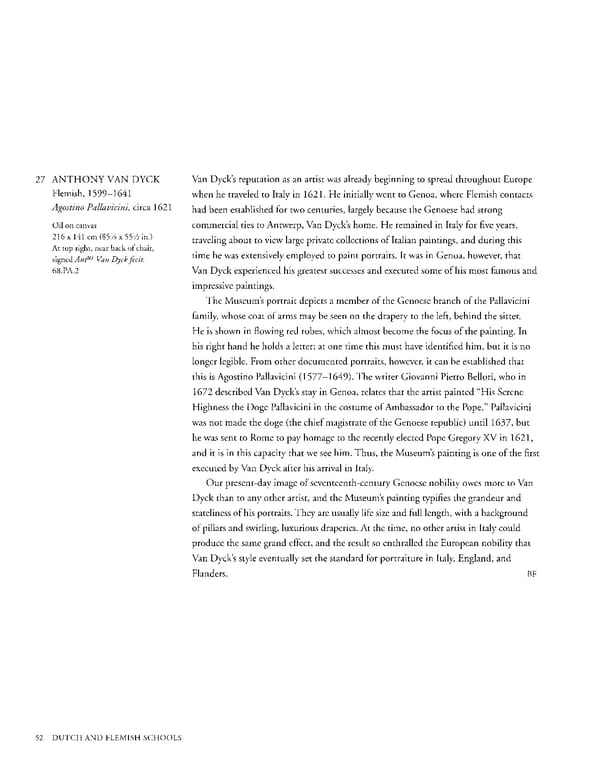27 ANTHONY VAN DYCK Van Dyck's reputation as an artist was already beginning to spread throughout Europe Flemish, 15991641 when he traveled to Italy in 1621. He initially went to Genoa, where Flemish contacts Agostino Pallavicini, circa 1621 had been established for two centuries, largely because the Genoese had strong Oil on canvas commercial ties to Antwerp, Van Dyck's home. He remained in Italy for five years, 216 x 141 cm (85 x 55½ in.) traveling about to view large private collections of Italian paintings, and during this At top right, near back of chair, us time he was extensively employed to paint portraits. It was in Genoa, however, that signed Ant Van Dyck fecit. 68.PA.2 Van Dyck experienced his greatest successes and executed some of his most famous and impressive paintings. The Museum's portrait depicts a member of the Genoese branch of the Pallavicini family, whose coat of arms may be seen on the drapery to the left, behind the sitter. He is shown in flowing red robes, which almost become the focus of the painting. In his right hand he holds a letter; at one time this must have identified him, but it is no longer legible. From other documented portraits, however, it can be established that this is Agostino Pallavicini (15771649). The writer Giovanni Pietro Bellori, who in 1672 described Van Dyck's stay in Genoa, relates that the artist painted "His Serene Highness the Doge Pallavicini in the costume of Ambassador to the Pope." Pallavicini was not made the doge (the chief magistrate of the Genoese republic) until 1637, but he was sent to Rome to pay homage to the recently elected Pope Gregory XV in 1621, and it is in this capacity that we see him. Thus, the Museum's painting is one of the first executed by Van Dyck after his arrival in Italy. Our presentday image of seventeenthcentury Genoese nobility owes more to Van Dyck than to any other artist, and the Museum's painting typifies the grandeur and stateliness of his portraits. They are usually life size and full length, with a background of pillars and swirling, luxurious draperies. At the time, no other artist in Italy could produce the same grand effect, and the result so enthralled the European nobility that Van Dyck's style eventually set the standard for portraiture in Italy, England, and Flanders. BF 52 DUTCH AND FLEMISH SCHOOLS
 Masterpieces of the Getty Museum: Paintings Page 52 Page 54
Masterpieces of the Getty Museum: Paintings Page 52 Page 54